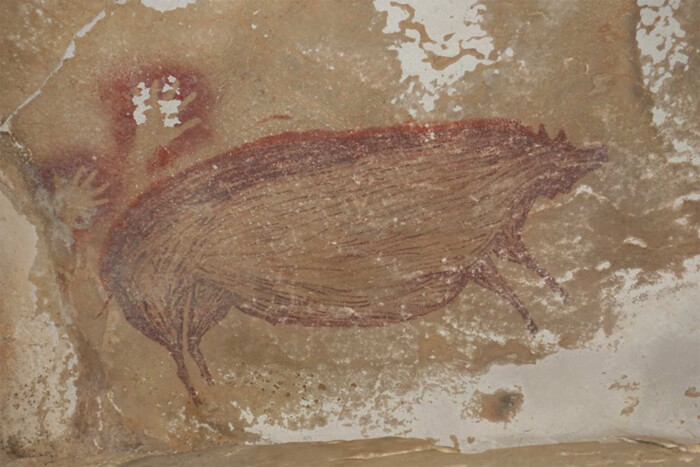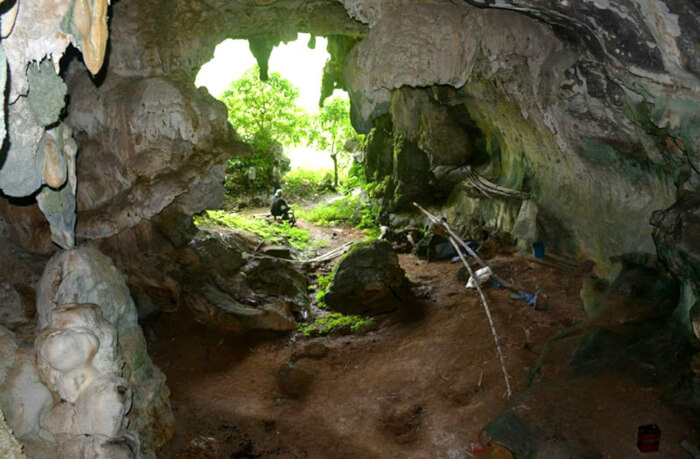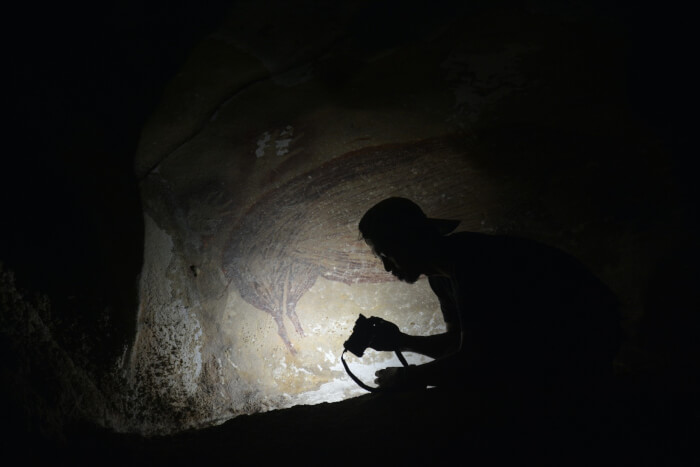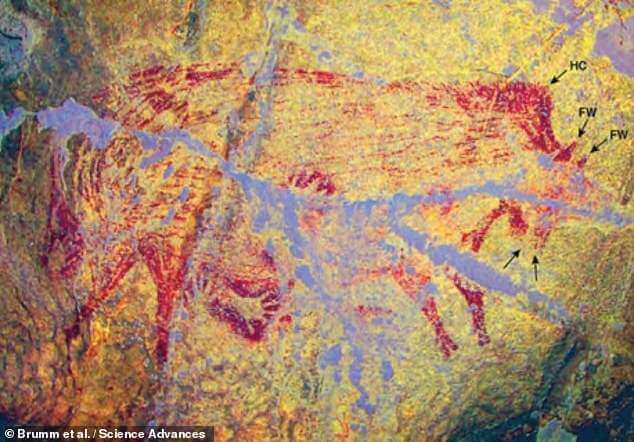45,500-Year-Old Wild Boar Painting Might Be World’s Oldest-Known Figurative Artwork
A research has stated that the world’s oldest-known figurative art piece might be an image of a warty pig drawn onto an Indonesian cave wall roughly 45,500 years ago. The painting of the native wild boar was discovered on the wall of the Leang Tedongnge cave in the south of the island of Sulawesi, by researchers from Australia and Indonesia.
They claimed that the initial proof of the existence of anatomically modern humans on Sulawesi came from this life-size image. Additionally, researchers also discovered a second painting of a warty pig, 13,500 years younger, in the nearby Leang Balangajia cave to the south of Leang Tedongnge.
They revealed that the image also featured 4 hand stencils and several other poorly preserved animal paintings. 'It shows a pig with a short crest of upright hairs and a pair of horn-like facial warts in front of the eyes — a characteristic feature of adult male Sulawesi warty pigs,' according to study author and archaeologist Adam Brumm of Griffith University in Queensland.
The painting, which was discovered in another limestone cave in the area, illustrated hybrid human-animal beings hunting Sulawesi warty pigs and dwarf bovids. Professor Brumm explained that Leang Tedongnge is located in a valley enclosed by steep limestone cliffs, accessible only by a narrow cave passage in the dry season because the valley floor is completely flooded in the wet.
The team also shared that the isolated Bugis people, living in the secret valley, said that Westerners had never came here. Basran Burhan, fellow study author and archaeologist from Griffith University, said that “Humans have hunted Sulawesi warty pigs for tens of thousands of years.”
“Rock art is very challenging to date,” Professor Aubert explained. “However, rock art produced in limestone caves can sometimes be dated using Uranium-series analysis of calcium carbonate deposits - ‘cave popcorn’ - that form naturally on the cave wall surface used as a "canvas" for the art.”
“At Leang Tedongnge, a small cave popcorn had formed on the rear foot of one of the pig figures after it had been painted, so when dated, it provided us with a minimum age for the painting,” Professor Aubert continued. The second warty pig painting, the one in Leang Balangajia, might have been daubed on the cave wall at least 32,000 years ago, thanks to Uranium dating.
Meanwhile, Professor Brumm thought that this discovery highlights the spectacular antiquity of Indonesia’s rock art and its remarkable importance for interpreting the deep-time history of art and its role in the initial story of humanity.
The team also shared that the Sulawesi rock art dated might contain some of the first proof for the existence of modern human in Wallacea, the area encircling the islands between Asia and Austrlia-New Guinea. Professor Aubert explained, “Our species must have crossed through Wallacea by watercraft in order to reach Australia by at least 65,000 years ago.”
They claimed that the initial proof of the existence of anatomically modern humans on Sulawesi came from this life-size image. Additionally, researchers also discovered a second painting of a warty pig, 13,500 years younger, in the nearby Leang Balangajia cave to the south of Leang Tedongnge.
They revealed that the image also featured 4 hand stencils and several other poorly preserved animal paintings. 'It shows a pig with a short crest of upright hairs and a pair of horn-like facial warts in front of the eyes — a characteristic feature of adult male Sulawesi warty pigs,' according to study author and archaeologist Adam Brumm of Griffith University in Queensland.
 Source: Maxim Aubert
Source: Maxim Aubert
The painting, which was discovered in another limestone cave in the area, illustrated hybrid human-animal beings hunting Sulawesi warty pigs and dwarf bovids. Professor Brumm explained that Leang Tedongnge is located in a valley enclosed by steep limestone cliffs, accessible only by a narrow cave passage in the dry season because the valley floor is completely flooded in the wet.
The team also shared that the isolated Bugis people, living in the secret valley, said that Westerners had never came here. Basran Burhan, fellow study author and archaeologist from Griffith University, said that “Humans have hunted Sulawesi warty pigs for tens of thousands of years.”
 Source: AA Oktaviana
Source: AA Oktaviana
“Rock art is very challenging to date,” Professor Aubert explained. “However, rock art produced in limestone caves can sometimes be dated using Uranium-series analysis of calcium carbonate deposits - ‘cave popcorn’ - that form naturally on the cave wall surface used as a "canvas" for the art.”
“At Leang Tedongnge, a small cave popcorn had formed on the rear foot of one of the pig figures after it had been painted, so when dated, it provided us with a minimum age for the painting,” Professor Aubert continued. The second warty pig painting, the one in Leang Balangajia, might have been daubed on the cave wall at least 32,000 years ago, thanks to Uranium dating.
 Source: AA Oktaviana
Source: AA Oktaviana
Meanwhile, Professor Brumm thought that this discovery highlights the spectacular antiquity of Indonesia’s rock art and its remarkable importance for interpreting the deep-time history of art and its role in the initial story of humanity.
The team also shared that the Sulawesi rock art dated might contain some of the first proof for the existence of modern human in Wallacea, the area encircling the islands between Asia and Austrlia-New Guinea. Professor Aubert explained, “Our species must have crossed through Wallacea by watercraft in order to reach Australia by at least 65,000 years ago.”
 Source: Brumm et al.
Source: Brumm et al.
Share this article
Advertisement